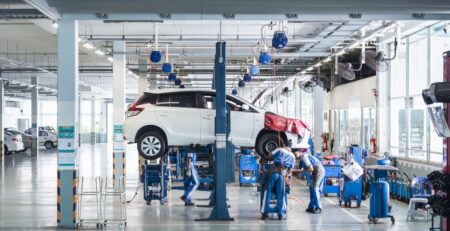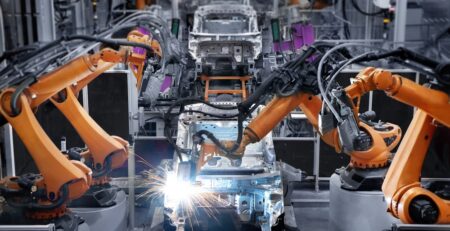Kick It Into Overdrive | 6 Ways to Maximize Productivity in Dealerships & Auto Shops
Even the hardest-working, most experienced service advisors can run into productivity hiccups at busy auto shops. While a busy shop often means the business is thriving (which is what we want), a bottom line that doesn’t reflect the number of hours put in points to a lack of productivity in car dealerships and auto shops.
To ensure you’re seeing a healthy return on investment (ROI), it’s imperative that high activity levels in your shop are productive and not the result of bottlenecks and constraints faced by your service reps and technicians. While it’s natural for a shop or service department to face challenges like customer complaints, staff shortages, and a high volume of service requests, it’s crucial that persistent issues in productivity are resolved. Having solutions on hand, like efficient automotive route sheet software and Multi-Point Inspection (MPI) software, particularly when integrated with a production efficiency platform such as Workflow 360, can solve your productivity problems in a jiffy!
The Productivity Engine | What Really Moves the Needle
An empty service bay clearly generates no revenue, but when your service pays are full yet inefficient, it can actively lead to profit loss. When vehicles aren’t rotating through your service bays as efficiently as they should ideally be, it can create a nasty bottleneck that results in lost revenue. These inefficiencies can typically stem from several common issues, such as:
- Delays in client approvals: Technicians are left waiting for customer go-aheads.
- Poor communication with the parts department: Technicians experience downtime waiting for necessary parts information.
- Ineffective internal communication: A general lack of streamlined communication within the service department or shop itself.
- Lack of software integration: Technicians spend too much time manually tracking the progress of repairs and services due to disconnected systems.
- Absence of real-time reporting: Managers and technicians lack immediate visibility into a vehicle’s service status.
Fueling Focus | 6 Keys to Unlocking True Productivity
1. Improve Communication
Clear, consistent communication is necessary in any business, especially for auto shops and service centers, where mistakes and repeated efforts can result in significant loss or damage. It’s important to consider the methods your employees and managers use to communicate. While face-to-face communication is valuable and easy for urgent and more serious matters, it’s not always sustainable with day-to-day operations. Your automotive service software should have features that allow accessible communication to all areas of the business and the customer, allowing for faster approvals and more efficient repairs, and an all-around easier process in general.
Recommendation: Consider implementing a production efficiency platform to solve the issue if you’re finding consistent constraints with your existing software.
2. Embrace Technology
Businesses need to stay up to date with the latest and greatest technology if they want to remain competitive. In fact, having an innovative production efficiency platform provides service departments and autoshops with enhanced reporting, customer service features, cloud-based data storage, and text messaging features. Advancements in technology help alleviate repeated efforts and reduce the time it takes to complete certain tasks. With the latest dealership software or dealership management plugin, customers can be informed of the job status, with updates that indicate when the technicians start work on the vehicle, when the vehicle is waiting for parts, and when the job is complete – sounds super handy, doesn’t it?
Recommendation: Utilize a platform that improves efficiency for your service technicians by allowing them to upload and send customer photos and images via text or email to speed up the approval process.
3. Analyze and Plan Accordingly
To add to the advantages of technology above, an automotive service software combined with an integrated production efficiency platform gives managers a bird’s eye view of the business, allowing for improved analytics and more efficient planning, and fewer headaches!
Recommendation: Use software that incorporates real-time reporting and analytics so managers can plan for a smoother workflow and identify busy times that require more staff.
4. Work Between Jobs
Most cloud-based automotive service platforms enforce step-by-step task completion, which leads to increased downtime and technicians needing to wait before additional services can be performed, which works against your company’s productivity. With a proper production efficiency platform, techs can work between jobs whenever possible, allowing tasks to be placed on hold and returned to seamlessly.
Recommendation: Find a production efficiency platform that enables you to improve your workflow by taking on multiple tasks at the same time.
5. Eliminate Bottlenecks
Some of the biggest contributors to productivity issues are bottlenecks and unnecessary or repetitive tasks. By continually analyzing your processes, you can identify where these issues are occurring and take the necessary steps to reduce them.
Recommendation: Employ real-time reporting, two-way communication, and a smart platform that enhances your workflow to ensure you know what’s happening in your shop.
6. Automate Your Scheduling
Automating your scheduling process can seriously cut down on administrative overload and improve your overall efficiency. Manual scheduling is prone to errors, double bookings, and inefficient use of your technicians’ valuable time. By implementing an automated scheduling system, you can optimize technician workloads, ensure a steady flow of vehicles, and even send customers automated appointment reminders.
Recommendation: Ensure that your service software includes scheduling capabilities and allows for flexible booking options and real-time adjustments.
The Bottom Line on Productivity | What Really Counts
Almost every single industry revolves around technology and software, and the automotive industry is no exception. With automation, artificial intelligence, and cloud technology on the rise, dealerships and service centers are now able to become more productive. Innovative software solutions are continuing to evolve and transform the automotive industry, enhancing productivity for car dealerships and auto shops alike!
To learn more about Workflow 360’s capabilities and improve productivity in your service department or shop, contact us today.











